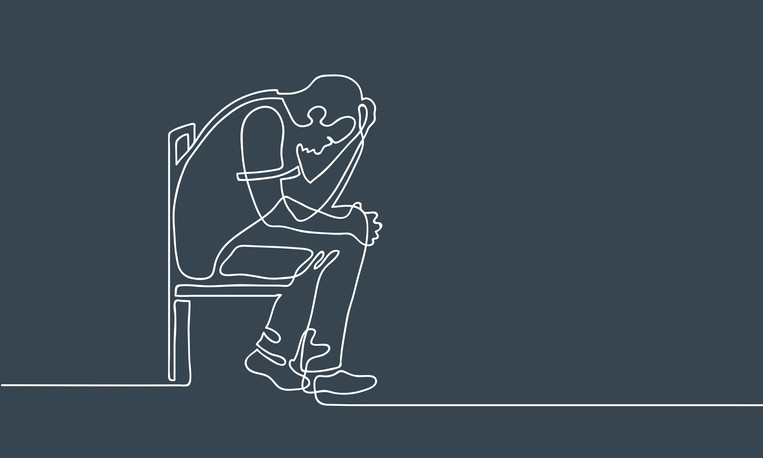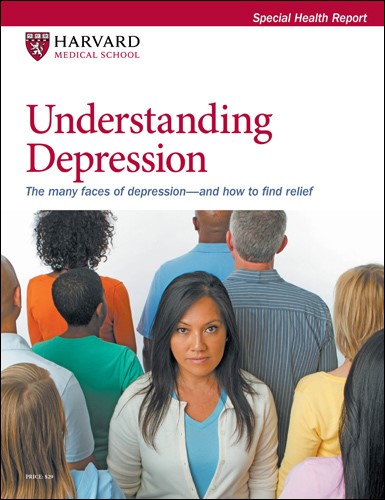Breakthrough in brain stimulation offers cautious hope for depression
A dramatically different approach to transcranial magnetic stimulation is promising, but needs further study.

The basic tools we have for treating depression haven't changed greatly in recent years. Medications and talk therapies are a mainstay. Lifestyle approaches, such as encouraging physical activity, sufficient sleep, and social connection, are often part of the package. If depression fails to lift, the next line of treatment for some may be a noninvasive form of brain stimulation called transcranial magnetic stimulation (TMS) that is helpful in certain cases and has very few side effects.
Yet TMS requires a serious time commitment — typically a total of 36 sessions over six to nine weeks. Studies show that about a third of people who try it find that it completely relieves their depression. Recently a small, short-term study in the American Journal of Psychiatry suggested that a radical rethinking of the way TMS is delivered may greatly boost effectiveness while shortening the treatment period to just five days.
What is transcranial magnetic stimulation?
Certain areas of the brain are known to be implicated in depression and other mood disorders. TMS uses powerful electromagnets to safely activate these regions. A device positioned on the upper forehead delivers short electromagnetic pulses. These pass through the skull to stimulate nerve cells in the targeted area. Over time, this technique leaves that part of the brain more active, which is thought to then affect entire brain networks responsible for regulating mood.
The most common side effect is temporary headache or discomfort at the site of stimulation. The most serious and rare potential side effect is seizure.
How effective is standard TMS for depression?
Despite advances since 2008, when the FDA first cleared a TMS device to treat depression, not everyone finds TMS to be effective.
When considering treatment options, it helps to understand the difference between response and remission. Depression symptoms often are measured using tools like the Hamilton Depression Rating Scale. Response to treatment means a 50% or greater reduction in symptoms; remission means the absence of symptoms defined in each scale.
Combined research on standard TMS shows about 30% of people experience a full remission from depression. This number varies somewhat across studies, devices, and treatment protocols. Notably, though, when antidepressants have failed to relieve depression, even this modest remission rate is higher than what would be expected if a person simply tried a different medication.
When TMS does help, depression starts to ease after a few weeks and continues to improve through the full course of treatment. These benefits last for about a year, on average. If depression returns, another course of TMS or a different treatment is often needed.
The staggering promise of the SAINT protocol
Researchers from Stanford modified standard TMS techniques to create a novel protocol called Stanford Accelerated Intelligent Neuromodulation Therapy (SAINT or SNT), which
- uses MRI to select what is likely to be the optimal spot in the brain for stimulation
- triples the number of pulses per session
- increases the number of sessions to 50
- condenses treatment into just five days by doing 10 sessions per day.
In a single, one-month study, 29 people with treatment-resistant depression were randomly assigned to receive SAINT or a sham version. At the end of the month, 78% in the SAINT group had experienced full remission compared with 7% in the sham group. Remarkably, this efficacy surpasses even electroconvulsive therapy, the current gold standard for treatment-resistant depression. The SAINT treatment appeared to be safe and well tolerated, on par with standard TMS.
Many unknowns in new approach to TMS
Given its potential, the FDA granted clearance for Magnus Medical, a biomedical company working with Stanford, to market SAINT through a 510(k) pathway — a process that relies on the safety track record of previously approved devices for TMS. However, many questions must be answered before this novel treatment can be widely adopted.
- Will high rates of remission hold up across varied treatment sites and diverse populations? Ideally, new treatment options are vetted in larger, multicenter, randomized controlled trials before reaching the broader world.
- How long-lasting are the positive effects? A small, short-term study cannot show this, or suggest the best approach if depression recurs after a person completes accelerated treatment.
- Do side effects differ from standard TMS? While the adverse effects of standard TMS are well established and generally well tolerated, we do not yet know if the same can be said for the SAINT protocol, given the small number of people who have tried it to date.
- Which components in the SAINT protocol have the biggest impact on its striking remission rates? Can high response rates be achieved with more accessible techniques? The SAINT protocol, as described, requires extensive expert planning using high-tech approaches to neuroimaging that are not available in most parts of the country. Its implementation also requires dedicated equipment, staffing, and space that could disrupt other clinical operations. Perhaps adjustments can be made that can maintain the benefit while improving the accessibility for a wider array of TMS providers and their patients.
Moving forward with a novel treatment: Buyer beware
Depression care is an area of striking and ongoing need in this country. Advances like the SAINT protocol carry enormous potential, but also many unknowns. With such excitement about the results of the new approach, it is no surprise that clinics are springing up around the country offering similar accelerated TMS services. But how strictly will these clinics adhere to all elements of the SAINT protocol? We don't have those answers, nor can we be sure yet that following all the elements will deliver the same results in larger, long-term studies.
For now, most sites offering variants of this new treatment approach will not be covered by insurance. Accelerated treatment will occur at substantial cost while still being limited by many of the unknowns discussed above. Before moving forward, people seeking treatment for depression and their clinical teams will have to determine what level of uncertainty feels comfortable to them.
The SAINT technique has the potential to transform the lives of millions of people living with depression, but the recent study and its subsequent FDA clearance are only the first steps. Figuring out exactly how this approach fits in is still to come.
About the Author

Adam P. Stern, MD, Contributor
Disclaimer:
As a service to our readers, Harvard Health Publishing provides access to our library of archived content. Please note the date of last review or update on all articles.
No content on this site, regardless of date, should ever be used as a substitute for direct medical advice from your doctor or other qualified clinician.
















